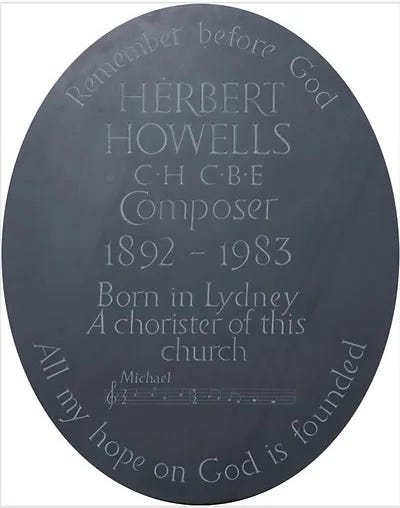Herbert Howells (1892-1983) and his choral and organ music
Last week I attended a concert given at St. Martin-in-the-Fields, London by the BBC Singers of the music of Herbert Howells. Ashley Grote (Norwich Cathedral) was the accompanist and also soloist. The range of music covered his entire composing life including Psalm 23 from the Requiem (1932), the Te Deum from Collegium Regale (1944) the Gloucester Service (1946), Behold, O God our defender (1952), Take Him Year for Cherishing (1963) and A Grace for 10 Downing Street (1972). In addition, there were performances of No. 3 of Set 2 of Psalm Preludes and Master Tallis’s Testament (1940).
My first acquaintance with the music of Herbert Howells was hearing one of his carols performed during the Kings College Service of Nine Lessons and Carols in the early 1960s. The concert brought home to me how little of his vast list of compositions I am familiar with. Howells managed to achieve a particular harmonic style that (based just on the concert) matured and developed whilst remaining distinctive.
This is a memorial to Howells in the church in Lydney, his birthplace. Around the lower edge you can see “All my hope on God is founded” and above the text the opening bars of his hymn tune Michael, the name of his son who died from polio aged just eight, something that understandably deeply affected Howells for the rest of his life.
A good introduction to this style is given in a short video by Ronny Krippner, who highlights the composer’s skills as an organist and improvisor. A feature of the organ music is the ‘arch’ shape, starting very quietly, building very rapidly to a crescendo before subsiding to a very quiet close. One of his earliest works that I aways enjoy playing is the first Psalm Prelude, written in 1915 when he was 23. In his video recording at St. John’s Cathedral, New York, David Briggs adds a personal comment on his love for this composition.
My experience with his organ music is that Howells always writes something that is very playable. Certainly they take effort and practice but the rewards always worth the work. I have to admit that I have never really got my fingers around his Paean. At the other end of the spectrum come Two Pieces for manuals, written in 1959.
I do feel that his music needs the ‘right’ organ. At the concert Ashley Grote was using the Walker organ in the church and to me it did not hug the singers in the way that a Willis, Harrison & Harrison or Nicholson organ (amongst others) might do, something that Briggs notes in his video.
In my 24 October post I noted the value of academic research in gaining perspectives on music and performance. In the case of Howells there are probably 20 or more theses that have been published, a testament to the interest in his harmonic language and music architecture.
Some examples, related to my comments above, include (links checked 21 November 2023)
Career and reputation of Herbert Howells Richard Marshall
The style and development of Herbert Howells’ Evening Canticle Settings 1918-1975 Sophie Cleobury
A stylistic study of the anthems of Herbert Howells together with a catalogue of the anthems and evening canticles Mark Mitchell
‘Beauty Springeth Out of Naught’: Interpreting the Church Music of Herbert Howells Jonathan Clinch
Rhapsody in the Organ Works of Herbert Howells: An Examination of Rhapsody-Based Organ Works Donald Grice
There are of course a number of books, of which probably the most comprehensive is The Music of Herbert Howells, edited by Philip Cooke and David Maw and published in 2013. There is a Royal Forest of Dean Herbert Howells Society but this seems not to be active at present.


